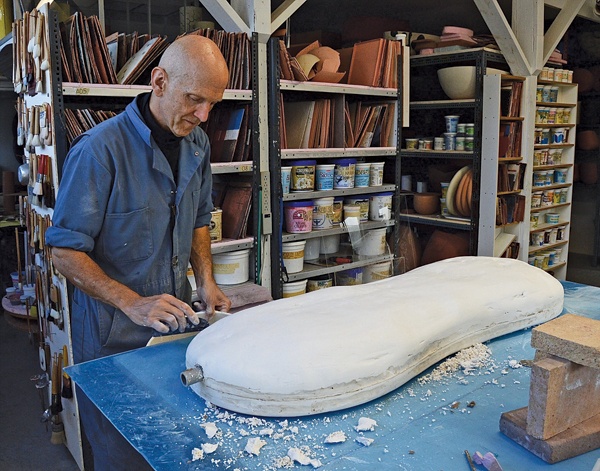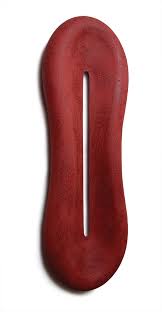CLAY NATION
Posted by Deirdre | Filed under Blog

Canadian ceramicist Steven Heinemann crafts his legacy
If the children in the tree-filled park knew that in the dark and cavernous basement of the four-storey apartment building next door lurked a quiet man with a grizzled beard who spent his days working magic out of earth and fire they’d probably flee their sun-dappled swings in terror.
Even an adult climbing down the stairs that lead to Steven Heinemann’s subterranean abode feels a pinch of dread when faced with dusky labyrinthine passageways full of cobwebs and chill.
The fear abates when the dweller of the grotto steps forward out of the darkness to take your hand. The grip is strong, confident and lingering. So is the gaze of his dark brown eyes. “Welcome,” he says with a toothy grin. The hand pulls you in toward him and the warmth that emanates from the wall of ovens that line one side of the underground room.
Technically speaking, the squat-shaped ovens are kilns. In these the Ontario-born ceramicist bakes the work he moulds out of clay. Some of that work will be celebrated today in Hull, where Heinemann, 38, will receive the $20,000 Saidye Bronfman Award, the most prestigious award for fine crafts in Canada.

The presentation, taking place at the Canadian Museum of Civilization, will coincide with the launch of Transformation: Prix Saidye Bronfman Award 1977-1996, a travelling exhibition of work by previous recipients of the award, now in its 20th year. Heinemann, whom the selection committee chose from a distinguished list of 18 craft artists in all major media from across the country, is represented in the touring show by sculptural vessels baked several times over in his studio kilns to achieve their distinctive textured surfaces. Some of these pieces will also be showcased in a Toronto exhibition opening Friday at Prime Gallery on McCaul Street.
Heinemann’s work also forms part of permanent collections across North America, including The Canadian Craft Museum in Vancouver, the Albright Knox Gallery in Buffalo, N.Y., the American Craft Museum in New York and the Art Gallery of Nova Scotia. In 1988 and 1994 he won the Prix d’Excellence at the National Biennial of Ceramics and in 1995 the Judges Award at the Ceramic International in Mino, Japan. Also a two-time recipient of the Merit Award at the Fletcher Challenge International in New Zealand, Heinemann has a reputation that extends to museum collections in Taiwan and the Netherlands.
Heinemann is a self-described farm boy, the son of Hungarian immigrants who settled in rural Ontario in the 1950s. He first started working with clay when he was in his teens. His family, though sod farmers, never looked at art as an alien or esoteric preoccupation.

“My parents are fairly cultured people,” says Heinemann, a slight man with strong forearms and long-fingered hands. “My dad works the land but he also reads a lot and goes to the symphony. Art was always something that was respected. It was not separate from life, it was something that enhanced life and made life good.”
It was when he was in high school that Heinemann decided to be an artist. He studied ceramics at Sheridan College School of Craft and Design in Toronto and after graduating in 1979 continued his training at the Kansas City Art Institute with a bursary from the Ontario Arts Council. He received his MFA in Ceramics from New York State College of Ceramics at Alfred University in 1983.
His parents, he says, were at first skeptical of his artistic ambition. If they were concerned that their son, as an artist, would struggle to make a living, he was right:
“The bottom line is you have to love it,” Heinemann says. “You have to want to do it at all costs because God knows, you’re always working in isolation, you rarely get recognition and the money’s scarce. An award like this (the Bronfman Award) is not something you can count on. So you have to have the goods to sustain you.”

Heinemann also remained loyal to his family’s rural roots by making nature the central focus of his art. In the 15 years that he has been a professional artist (his first solo exhibition was in 1982 at the Ontario Crafts Council), Heinemann’s theme explores the relationship between humans and nature. “My work is really involved in the organic world,” he says, reaching out to touch some of the finished pieces that litter his studio. “It’s about finding metaphors in organic processes that relate to our experience of the world as human beings.”
He describes his work as evolving out of an early interest in pottery and in particular what he calls “pottery space,” or what a layman might simply call the inside of a bowl.
“The interior space has a kind of imaginative resonance that draws you in . . . it’s more of an absence of the presence kind of thing . . . it’s where the power lies,” Heinemann says.
His work in the early 1980s moved away from bowl shapes and toward larger sculptural forms that originated out of an interest in fossil patterns in stone. Heinemann later began investigating more lifelike forms with oval-like shapes and no visible hollow. These, Heinemann, says, were meant to invoke cocoons, pods, husks or seeds – images of a life force waiting to explode. In his latest phases of work, Heinemann has returned to the bowl – “a fundamental ceramic form” that he says is “saturated with human presence.”
He takes a large clay vessel down off a shelf and places it on the concrete floor of his studio. Bending to his knees, he gently caresses the interior surface of the cradle-like bowl and points out the different patterns at the base. On one side is a black grid-like pattern topping a swirl of pearly white colour. On the other, a sea of dark colour upon which float floral shapes. The underlying whorls represent nature in its instinctive, undefined power. The overlaying patterns represent humans imposing order and rational structures on the chaos. His work actively embraces opposing forces: humanity versus nature, order versus disorder, technology versus organic processes.
In the past, his work has been more sculptural and monolithic in form. Some of these vessels are so large they stand in his underground studio like monumental totems of human endeavour. “Ceramics has always been something more than to just eat out of,” Heinemann says. “From the beginning it has also been tied to ceremony and ritual as well as to mean function. In Western culture, the rise of the Industrial Revolution knocked ceramics out of its place. For the last 150 years, craft has been grappling to re-find its relevance. I and a number of other Canadian crafts people are part of the experiment to restore dignity to handmade objects . . . and – you know what? – we’re making inroads around the world. And the main reasons is that we’re good.” Transformation: Prix Saidye Bronfman Award 1977-1996 will be at the Canadian Museum of Civilization in Hull, Que., from May 23 to Jan. 5, 1997. It then begins a two-year cross-Canada tour, with shows in Montreal, Toronto, Winnipeg, Victoria and other venues to be announced.
